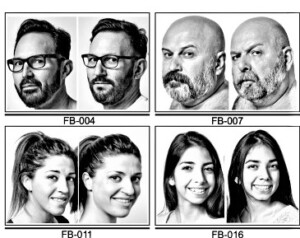Unrelated twins are no longer a myth. New findings published in Cell Reports suggest that apparent facial similarity between unrelated people extend to DNA and other similarities.
The human face is one of the most visible features of our unique identity as individuals. Interestingly, monozygotic twins share almost identical facial traits and the same DNA sequence but could exhibit differences in other biometrical parameters.
What are unrelated twins?
The expansion of the world wide web and the possibility to exchange pictures of humans across the planet has increased the number of people identified online as virtual twins or doubles that are not family related. These are called, in lay-language, look-alike humans, unknown twins, twin strangers, doubles, or doppelgänger, in German. Since the visible phenotype is determined by the genotype, one could assume some DNA similarity between these look-alikes. There may be also some other similarities, e.g., attitude and behavioral similarities.
Study design and findings in unrelated twins
The authors have characterized in detail a set of “look-alike” humans, defined by facial recognition algorithms, for their multiomics landscape. They studied the recognized sixteen pairs by SNP microarray, DNA methylation microarray, and microbiome sequencing. All the recruited participants in the study completed a comprehensive biometric and lifestyle questionnaire.
The authors report that Intrapair look-alikes share common genetic sequences such as face trait variants. DNA methylation and microbiome profiles only contribute modestly to human likeness. The identified SNPs impact physical and behavioral phenotypes beyond facial features.
Physical traits such as weight and height as well as behavioral traits such as smoking and education were correlated in look-alike pairs, suggesting that shared genetic variation not only relates to shared physical appearance but may also influence common habits and behavior.
Implications of the study
These findings do not only provide clues about the genetic setting associated with our facial aspect, and probably other traits of our body and personality, but also highlight how much of what we are, and what defines us, is really inherited, or instead is acquired during our lifetime.
This study supports the concept of heritability estimation that individuals correlated at the phenotype level share a significant number of genotypic correlations. The results are germane to the ongoing efforts to predict biometric traits from genomic data and the diagnosis of genetic disorders using facial analysis technologies.
These findings provide a molecular basis for future applications in various fields such as biomedicine, evolution, and forensics. Through collaborative efforts, the ultimate challenge would be to predict the human face structure based on the individual’s multiomics landscape.
Limitations of the study
The small sample size restricted the ability to perform large-scale statistical analyses. Thus, some partially negative results, such as those derived from the non-genetic data, could relate to an underpowered study. The used headshots were two-dimensional, black and white images, and valuable information regarding three-dimensional constructs, subtle skin tones, and unique facial features are lacking. In addition, the used SNP array does not allow for the analysis of other genetic components such as structural variations and shared rare events. Another limitation is that study samples were mostly from European origin. Thus, the study could not effectively address the impact of the used multiomics in other human populations.
Reference:
Joshi R.S. et al. Look-alike humans identified by facial recognition algorithms show genetic similarities. Cell Reports 40 (8) 111257, 2022. DOI: https://doi.org/10.1016/j.celrep.2022.111257
See also:
Facial Phenotyping by Artificial Intelligence
Go to the News Board
